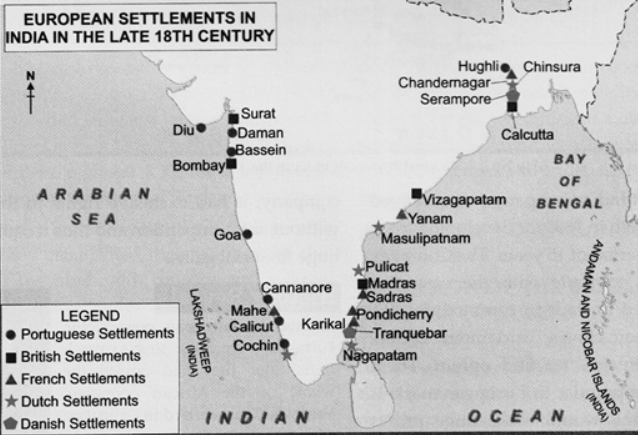Expansion of British Rule in India
The expansion of British rule in India from 1757 to 1857, starting with the Battle of Plassey, marked a period of gradual but significant British dominance. Through military victories, alliances, and administrative reforms, the British East India Company established control over various regions, leading to the eventual establishment of direct British colonial rule.
Battle of Plassey 1757: The Turning Point in the Expansion of British Rule
The Battle of Plassey in 1757 marked a significant turning point in Indian history, particularly in the context of British colonialism. This battle fought between the forces of the British East India Company and the Nawab of Bengal, Siraj-ud-Daulah, is often regarded as one of the most decisive battles in Indian history.

Consequences of the Battle of Plassey on British Colonial Expansion in India
- Control of Bengal: The British gained control over Bengal, the richest province in India.
- Economic Exploitation: Massive economic exploitation of Bengal resources by the British.
- Political Dominance: The British established political dominance over other Indian princely states.
- Foundation of British Rule: Laid the foundation for British colonial rule in India.
- Wealth Transfer: Enormous wealth was transferred from Bengal to Britain.
- Administrative Changes: Reorganization of the administrative system in Bengal.
- Military Strengthening: Strengthening of British military presence in India.
Conclusion
The Battle of Plassey itself in 1757 was as much a financial and political achievement as a battlefield triumph and set the tone for almost two hundred years of colonial British dominance of India. Securing Bengal effectively, the British East India Company established the financial and political structures for its expansive territorial growth all over the subcontinent. The years that followed witnessed the metamorphosis of a trading corporation into a mighty imperial power, propelled by equal measures of strategy and arms. These years of expansion radically transformed India's political landscape, leeched its wealth, and remodeled its destiny—leaving an inheritance that still shapes the country's socio-political landscape in the present day.

|
Interesting Facts:
The Black Hole Tragedy (June 20, 1756) in Calcutta: After the capture of Calcutta by Nawab Siraj-ud-Daulah of Bengal, a large number of British prisoners were allegedly confined overnight in a small prison cell known as the "Black Hole." The cell had limited space and inadequate ventilation, resulting in the deaths of many prisoners due to suffocation and heat exhaustion.
|
Battle of Buxar and Treaty of Allahabad
The Battle of Buxar, fought in 1764 between the forces of the British East India Company, led by Hector Munro, and a coalition of Indian rulers comprising the Nawab of Bengal, the Nawab of Awadh, and the Mughal Emperor Shah Alam II, ended with the defeat of the coalition. This war ultimately led to the signing of the Treaty of Allahabad in 1765.

Causes and Consequences of Battle of Buxar (1764)
Mir Qasim’s Challenge to British Supremacy in Bengal
- Mir Qasim sought independence and relocated his capital from Calcutta to Munger Fort.
- He treated Indian merchants and the English equally, without granting special privileges to the English.
- He employed foreign experts to train his army, which led to clashes with the British.
- These actions resulted in a conflict between Mir Qasim and the British in 1763, leading to war.
- Mir Jafar as Nawab: Following the assassination of Siraj-ud-Daulah, Mir Jafar was installed as the Nawab. However, the Company faced challenges with the cooperation of puppet nawabs.
- Mir Qasim and the Battle of Buxar: Mir Qasim briefly replaced Mir Jafar as the nawab but was defeated at the Battle of Buxar in 1764. Mir Jafar was then reinstated as the nawab.
Consequences of Battle of Buxar and British Ascendancy
- The British East India Company secured diwani rights over Bengal, Bihar, and Orissa through the Treaty of Allahabad (1765).
- The war led to the weakening of the Mughal Empire.
- It resulted in the expansion of British territory over significant parts of Bengal, Bihar, and parts of Awadh.
- The Company intensified its economic exploitation, leading to economic drain and impoverishment of the region.
The Role of Battles of Plassey and Buxar in Establishing British Supremacy in India
These two decisive battles laid the foundation for British supremacy in India, reshaping the political and economic landscape of the subcontinent.

|
BATTLE OF PLASSEY 1757
|
BATTLE OF BUXAR 1764
|
- The Battle of Plassey was fought between the British East India Company and the Nawab of Bengal, Siraj ud-Daulah.
- Cause: Siraj ud-Daulah's forces outnumbered the British, but the British received support from Mir Jafar, a discontented nobleman in Siraj ud-Daulah's court.
Benefits to the British Empire
- Territorial Expansion: Plassey provided the British East India Company control over Bengal, a pivotal region for trade and revenue.
- Economic Advantages: Control over Bengal's wealth enriched the Company, funding further expansion and operations.
- Political Influence: Established British authority, facilitating future dominance over Indian politics.
- Military Supremacy: Demonstrated British military prowess, deterring local resistance and rivals.
- Imperial Ambitions: Plassey marked a significant step towards British imperial ambitions in India, setting a precedent for subsequent conquests.
|
- Background: Fought between the East India Company and a coalition of Indian rulers comprising the Mughal Emperor Shah Alam II, Nawab of Oudh Shuja-ud-Daula, and the Nawab of Bengal Mir Qasim.
- Cause: Mir Qasim's discontent with the British led to the formation of a coalition against them.
Benefits to the British Empire
- Treaty of Allahabad Negotiated: Following Buxar, Shah Alam II sought peace, leading to the Treaty of Allahabad negotiated by Robert Clive, marking the formal beginning of British imperial control.
- Foundation of British Empire: Buxar laid the groundwork for British imperial expansion across the Indian subcontinent.
- Control over Indian resources: The Company was now in possession of the revenues from the wealthiest of Mughal Provinces.
- Establishment of Dual Government: The Dual Government system, initiated by Clive, combined revenue collection (Diwani) and civil administration (Nizamat) in Bengal until later reforms.
- Subjugation of Regional Powers: The Nawab of Awadh was forced to pay war indemnity and cede territories, showcasing British authority.
- Transformation: Post-treaty, the East India Company evolved from a trading entity to a political powerhouse, expanding influence across the Indian subcontinent.
- Alliance as a tool of conquest: The Treaty of Allahabad can also be seen as the beginning of the British policy of building Subsidiary Alliances with Indian Rulers.
|
|
Interesting Facts:
- By the time Mir Jafar died in 1765, the mood of the Company had changed.
- Having failed to work with puppet nawabs, Clive declared: “We must indeed become nawabs ourselves”.
|




















